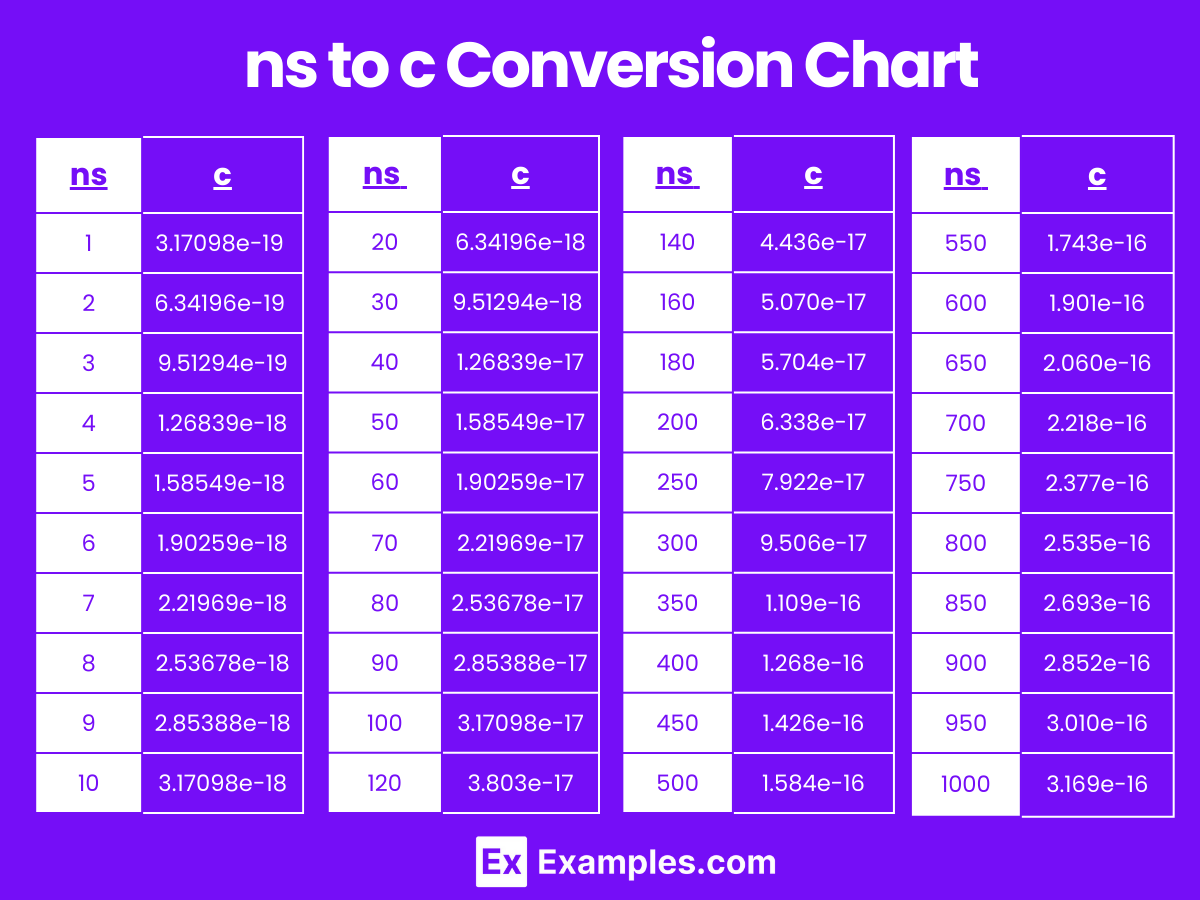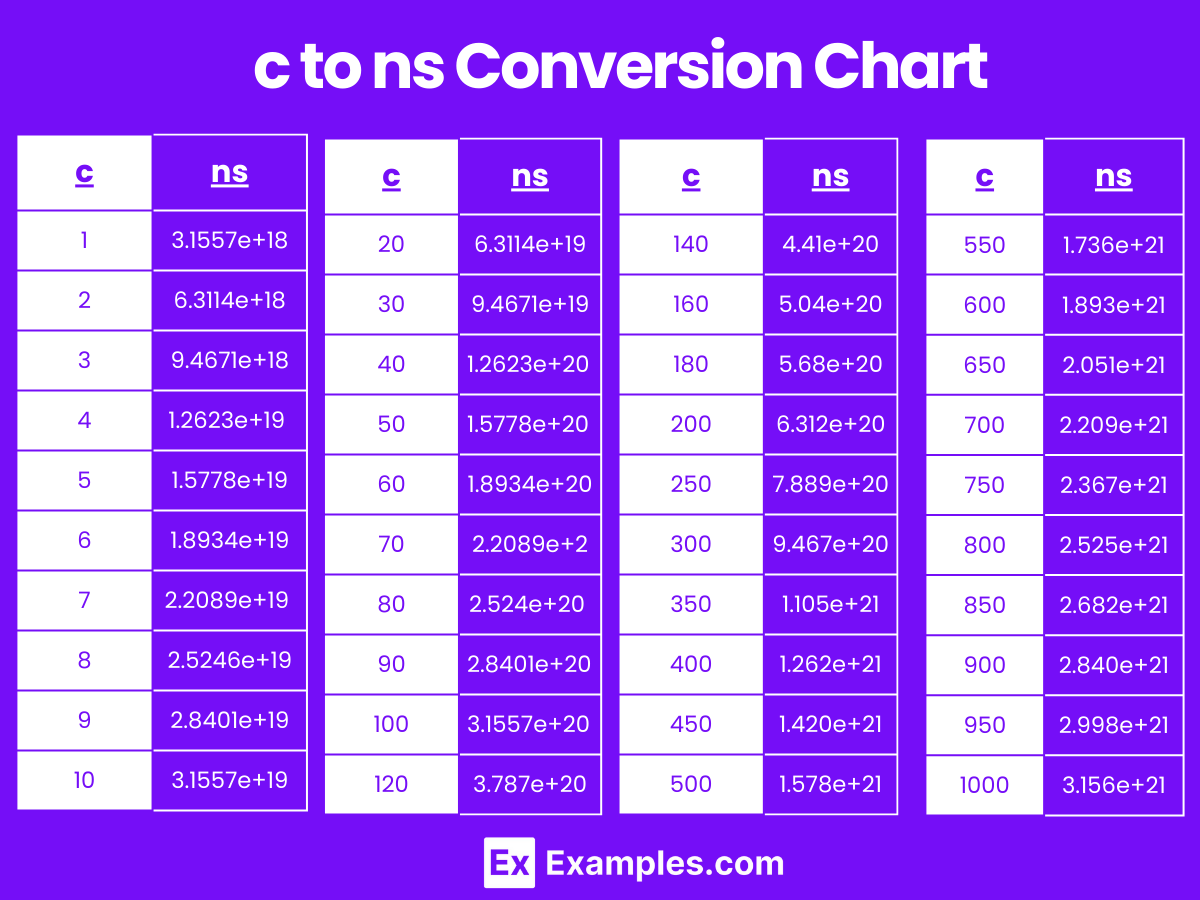Convert nanoseconds to centuries and vice versa effortlessly on Examples.com. Enter your data to get accurate and immediate results.
Conversion Factors:
- Nanoseconds to Centuries: 1 century = 3.1556952e+18 nanoseconds
- Centuries to Nanoseconds: 1 nanosecond = 3.17098e-19 centuries
How to Convert Nanoseconds to Centuries:
To convert nanoseconds to centuries, divide the number of nanoseconds by 3.1556952e+18.
Centuries=Nanoseconds/3.1556952𝑒+18
Example:
Convert 1,000,000,000,000,000,000 nanoseconds to centuries.
Centuries=1,000,000,000,000,000,000/3.1556952𝑒+18=0.3171 centuries
How to Convert Centuries to Nanoseconds:
To convert centuries to nanoseconds, multiply the number of centuries by 3.1556952e+18.
Nanoseconds=Centuries×3.1556952𝑒+18
Example:
Convert 2 centuries to nanoseconds.
Nanoseconds=2×3.1556952𝑒+18=6.3113904𝑒+18 nanoseconds
Nanosecond to Century Conversion Table
| Nanoseconds (ns) | Centuries (c) |
|---|---|
| 1 ns | 3.17098e-19 c |
| 2 ns | 6.34196e-19 c |
| 3 ns | 9.51294e-19 c |
| 4 ns | 1.26839e-18 c |
| 5 ns | 1.58549e-18 c |
| 6 ns | 1.90259e-18 c |
| 7 ns | 2.21969e-18 c |
| 8 ns | 2.53678e-18 c |
| 9 ns | 2.85388e-18 c |
| 10 ns | 3.17098e-18 c |
| 20 ns | 6.34196e-18 c |
| 30 ns | 9.51294e-18 c |
| 40 ns | 1.26839e-17 c |
| 50 ns | 1.58549e-17 c |
| 60 ns | 1.90259e-17 c |
| 70 ns | 2.21969e-17 c |
| 80 ns | 2.53678e-17 c |
| 90 ns | 2.85388e-17 c |
| 100 ns | 3.17098e-17 c |
ns to c Conversion Chart

Century to Nanosecond Conversion Table
| Centuries (c) | Nanoseconds (ns) |
|---|---|
| 1 c | 3.1557e+18 ns |
| 2 c | 6.3114e+18 ns |
| 3 c | 9.4671e+18 ns |
| 4 c | 1.2623e+19 ns |
| 5 c | 1.5778e+19 ns |
| 6 c | 1.8934e+19 ns |
| 7 c | 2.2089e+19 ns |
| 8 c | 2.5246e+19 ns |
| 9 c | 2.8401e+19 ns |
| 10 c | 3.1557e+19 ns |
| 20 c | 6.3114e+19 ns |
| 30 c | 9.4671e+19 ns |
| 40 c | 1.2623e+20 ns |
| 50 c | 1.5778e+20 ns |
| 60 c | 1.8934e+20 ns |
| 70 c | 2.2089e+20 ns |
| 80 c | 2.5246e+20 ns |
| 90 c | 2.8401e+20 ns |
| 100 c | 3.1557e+20 ns |
c to ns Conversion Chart

Difference Between Nanosecond to Century
| Aspect | Nanoseconds (ns) | Centuries (c) |
|---|---|---|
| Definition | A nanosecond is one billionth of a second. | A century is a period of 100 years. |
| Scale | Extremely small unit of time. | Large unit of time. |
| Scientific Use | Common in high-precision fields like computing and quantum physics. | Used in historical and long-term planning contexts. |
| Conversion Factor | 1 nanosecond = 3.17098e-19 centuries. | 1 century = 3.1557e+18 nanoseconds. |
| Common Contexts | Measuring light travel, computer processor speeds. | Measuring human life events, historical periods. |
| Precision | Extremely precise unit of time. | Not precise; represents a very long period. |
| Practicality | Useful for measuring extremely short durations. | Useful for understanding longer time spans. |
| Historical Relevance | Not typically used in historical contexts. | Centuries are key to historical timelines. |
1. Solved Examples on Converting Nanosecond to Century
Example 1:
Convert 1,000,000,000,000 nanoseconds to centuries. Centuries=1,000,000,000,000/3.1556952𝑒+18=3.17098×10−7 centuries
Example 2:
Convert 50,000,000,000,000 nanoseconds to centuries. Centuries=50,000,000,000,000/3.1556952𝑒+18=1.58549×10−5 centuries
Example 3:
Convert 100,000,000,000,000 nanoseconds to centuries. Centuries=100,000,000,000,000/3.1556952𝑒+18=3.17098×10−5 centuries
Example 4:
Convert 1,000,000,000,000,000 nanoseconds to centuries. Centuries=1,000,000,000,000,000/3.1556952𝑒+18=3.17098×10−4 centuries
Example 5:
Convert 10,000,000,000,000,000 nanoseconds to centuries. Centuries=10,000,000,000,000,000/3.1556952𝑒+18=3.17098×10−3 centuries
2. Solved Examples on Converting Century to Nanosecond
Example 1:
Convert 1 century to nanoseconds.
Nanoseconds=1×3.1556952𝑒+18=3.1556952𝑒+18 ns
Example 2:
Convert 2 centuries to nanoseconds.
Nanoseconds=2×3.1556952e+18=6.3113904e+18 ns
Example 3:
Convert 5 centuries to nanoseconds.
Nanoseconds=5×3.1556952𝑒+18=1.5778476𝑒+19 ns
Example 4:
Convert 10 centuries to nanoseconds.
Nanoseconds=10×3.1556952𝑒+18=3.1556952𝑒+19 ns
Example 5:
Convert 20 centuries to nanoseconds.
Nanoseconds=20×3.1556952𝑒+18=6.3113904𝑒+19 ns
How does converting nanoseconds to centuries help in scientific research?
Converting nanoseconds to centuries helps in scientific research by providing a broader temporal context, making it easier to relate precise, short-term measurements to longer-term phenomena.
Why is it useful to convert nanoseconds to centuries?
Converting nanoseconds to centuries is useful in scientific and technological contexts where precise time measurements are needed, and understanding these measurements in larger time units can provide a clearer perspective.
Is there a simple way to remember the conversion from nanoseconds to centuries?
Yes, remember that 1 century = 3.1556952e+18 nanoseconds, so for quick conversions, divide the number of nanoseconds by this factor to get centuries.
How does the conversion from nanoseconds to centuries benefit in long-term technological planning?
Converting nanoseconds to centuries helps in understanding long-term technological impacts and advancements over extended periods, allowing for better future planning and strategy development.
What is the benefit of using a precise conversion factor for nanoseconds to centuries?
Using a precise conversion factor ensures the accuracy of calculations, which is crucial in scientific research and technological applications where even minor errors can lead to significant discrepancies.

